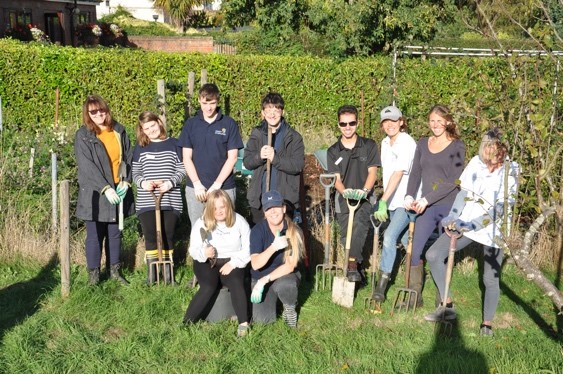Community Garden Update October 2022
October has seen the return of the Mission EmployAble interns, an end of season sale, and the beginnings of the long task of putting the garden to bed for the winter.
This year there are 11 interns from Mission EmployAble, all of whom are working in the Community Garden for half a day per week. So far we have been weeding (a lot!), digging up, splitting, and moving dahlias, planting bulbs, knocking back brambles, mulching perennials and re-laying woodchip paths. The weather has been very kind, and as we move into November, I hope it will continue to be so! They are a lovely team, and it’s a joy to host them.
The End of season sale was a great success – thanks to all who came along and got a nutritious bargain. There will be some more pot-luck dahlia tubers going spare – get in touch if you’d like some (I’m afraid now that they’re cut down, they are indistinguishable from each other, so it really is pot luck on colour). A particular highlight of the stall was an abundance of the most delicious eating apples (Braeburn), kindly donated by Pippa Alexander, and a different variety from the community allotment (name unknown). Late August to late November is PRIME British apple season – they are completely incomparable to a sad, imported New Zealand or South African apple – British apples are tastier, fresher, more nutritious, and you are supporting British growers!
Both the Community Garden and allotment are still looking pretty nice – the dahlias have flourished in the cooler, wetter conditions we’ve had recently, but we need to get on with putting it all to bed, so that, come February, we don’t go back to an unruly and depressing sight. Dahlias and Alstromerias both come through the winter unscathed as long as they are heavily mulched – leaf mould, compost, or matured woodchip are all excellent mulches to a minimum depth of one inch, preferable 2 or 3. Catching ephemeral weeds before they seed is a great thing to do at this time of year – we have found that, post the rain, and with warm conditions, we have swathes of groundsel and chickweed 😳 – pulled up or hoed off now, they make great compost fodder, whereas if you turn your back, they will seed EVERYWHERE!
Sunflowers that have stopped flowering are also great for making compost, though it is essential to chop them up first to increase the surface area. Save a few heads for seed for next year – I find that the self-seeded ones always do best, so I leave heads on the ground where I’d like them to grow. As we avoid digging, we tend to cut weeds and spent plants down, rather than pulling them out – this means the roots can act as a soil food and stabiliser over the winter. In some places, we then sow a green manure such as phacelia tanacetifolia or buckwheat to take advantage of winter sunlight to make biomass below and above ground.
The bees are still active at this time of year – they are mostly visiting the ivy flowers in a complete frenzy, but there are some on late asters, sunflowers, single flowered dahlias and sedums – it is so worth growing some late flowering species just for the bees – every drop of nectar counts at this time of year..
That’s all from the CG, except to say, as usual – ‘please let us have your fallen deciduous leaves if you don’t want them yourselves!’, and HUGE thanks to those who have already brought us lots. Every leaf is appreciated!

